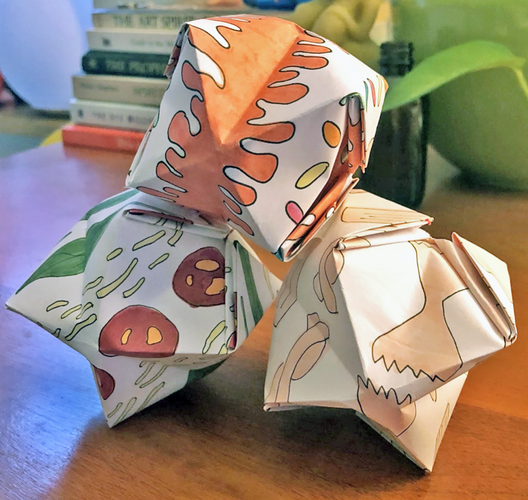Make with MAAM
Patterns of Our Present
Find inspiration in the story of Elizabeth “Mumbet” Freeman and Joana Vasconcelos’ Valkyrie Mumbet as you create an inflatable paper sculpture decorated with beautiful patterns.
This project was developed by MassArt Student Educators, Virginia Cannella '24 and Jennifer Lima '24, in collaboration with MAAM.

Materials
Paper, markers, crayons, colored pencils, etc.
Optional: scissors, glue, tape
Learn & Explore

Joana Vasconcelos’ Valkyrie Mumbet pays tribute to Elizabeth “Mumbet” Freeman, an enslaved woman who helped outlaw slavery in Massachusetts. In this large sculptural installation, Vasconcelos uses many materials, including a variety of fabrics for symbolic purposes. Capulana – bright and bold patterned fabric – covers most of the sculpture and Azorean lace decorates the surface.

Take a virtual tour of the sculpture!
Did you know?
Capulana fabric is worn in Mozambique as a symbolic type of clothing; this fabric can tell the story of a person's life, family, community.
The Azorean lace-making technique originated in the Portuguese islands of the Azores. The technique was created and perfected by women, and their craft became a way for them to make a livelihood separate from their home.
In Valkyrie Mumbet, Vasconcelos represents her home country of Portugal; Mozambique (where her parents grew up); and Massachusetts through the lens of the Portuguese diaspora. Vasconcelos acknowledges Portugal's role in the West African slave trade.
Consider
- What traditions would you like to represent or highlight?
- What about your own story could you represent through patterning?
Create!
Now it is your turn to make a similar sculpture. Vasconcelos’ Valkyrie Mumbet is made up of many different pieces connected together and inflated using air. Borrowing from Japanese craft, we will use the technique of origami to create an inflatable paper balloon decorated with beautiful patterns.
Create a Decorative Pattern

Cut your sheet of paper into a square. Get creative and use markers, crayons, or colored pencils to draw a design or pattern that is important to you. Vasconcelos uses patterns from Portuguese and from Mozambican culture – what will you choose to represent? Fill the whole square with patterns and shapes.

Fold a Paper Sculpture

Follow along with the video to learn how to fold your paper sculpture.
- Begin with your decorated, square piece of paper. Fold along each diagonal, then unfold back to the square. The creases will make an “X” in your paper.
- Fold in half to make a rectangle, then unfold back to the square. The crease will make a line halfway through your paper.
- Bring in the upper left and right corners. Fold in each corner to make a layered triangle (see 0:23).
- Fold the bottom left and right corners up to create a diamond shape – flip work and repeat on the other side (see 0:36).
- Fold each flap inwards so their points meet in the center. Flip work and repeat on the other side (see 0:54).
- Bring each loose flap on the top and bottom into the folds on the side: Fold a small triangle on each flap, and then fold again into the sides of the open flaps (see 1:17).
- Turn your origami to locate the tiny, open hole where each of the sides meet.
- Blow into the hole to inflate! Now you have your own sculpture inspired by Joana Vasconcelos’ Valkyrie Mumbet.

Reflect
Now that you have finished creating your own sculpture, take a look at your origami balloon. Think about the shape, colors, and imagery.
- In what ways is it similar to Vasconcelos’ sculpture, Valkyrie Mumbet?
- How is it different?
Think about the design you drew before folding up and inflating your balloon.
- What does your design mean to you?
- Why was it important to you to represent the symbols and colors that you did?
Vasconcelos included capulana fabrics to acknowledge Portugal’s role in the slave trade, since Elizabeth “Mumbet” Freeman was enslaved in Massachusetts.
- Why is it important for us to recognize our own role in history, and how that has affected other groups of people?
About the Creators of this Project
As a teaching museum, MAAM is educating and inspiring the next generation of artists at MassArt through exhibitions, programs, and engagement with our communities. This project was developed by MassArt Student Educators Virginia Cannella ‘24 and Jennifer Lima ‘24.
Virginia Cannella is a member of the class of 2024 in the Art Education program. She is a multi-disciplinary artist whose career goals center around museum education and curation.
Jennifer Lima is a sophomore double majoring in Art Education and Ceramics. She is continuing to explore different mediums and plans to either join the world of education through teaching secondary/post secondary art education or is interested in being a business owner, or both.